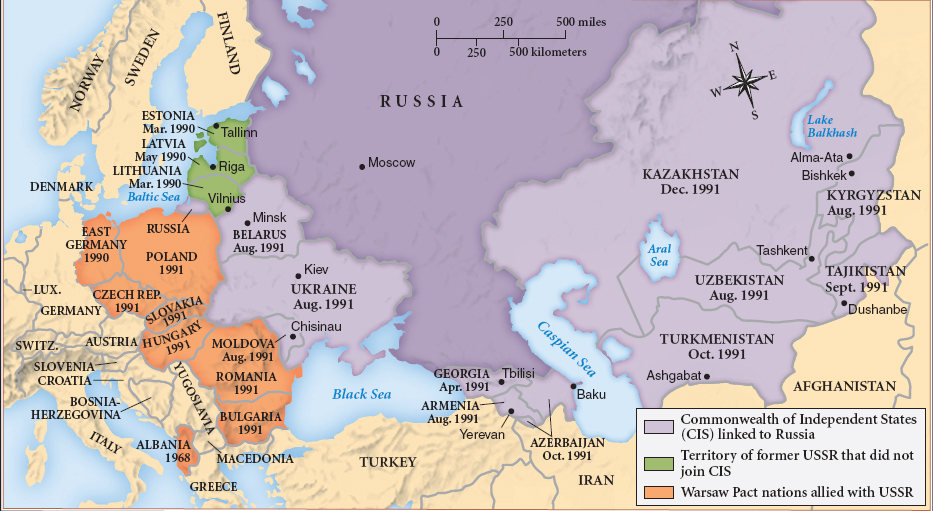AP-Style Short Answer Questions for Part 9
1. In 1980, Republican Ronald Reagan won the presidential election and ushered in a new era of conservatism in the United States. Use your knowledge of United States history to answer parts A, B, and C.
A) Identify and briefly explain ONE of the major components of the New Right’s agenda in 1980.
B) Provide and briefly discuss ONE example of a major domestic policy change initiated by the Reagan administration in the 1980s.
C) Provide and briefly discuss ONE example of a Reagan-era domestic policy that continued to shape American life in the twenty-first century.
Question 109.1
2. Question 2 refers to Map 30.3: The Collapse of the Soviet Union and the Creation of Independent States, 1989–1991.

Use your knowledge of United States history and Map 30.3 to answer parts A, B, and C.
A) Identify and briefly explain ONE element of Ronald Reagan’s foreign policy that led to the changes illustrated in this map.
B) Provide and briefly discuss ONE example of a new American foreign policy challenge that emerged as a result of the process illustrated in this map.
C) Provide and briefly discuss ONE example of an international event during which the United States and Russia worked together.
Question 109.2
3. Use your knowledge of United States history and the excerpt below to answer parts A, B, and C.
I spent a lot of time working on globalization when I was president, coming to terms with the fundamental fact of interdependence that goes far beyond economics: open border, easy travel, easy immigration, free flow of money as well as people, products, and services. I tried to figure out how to maximize the dynamism of global interdependence and still broaden its impact in terms of economics and opportunity. The one thing that I am quite sure of is that interdependence is not a choice, it’s not a policy, it is the inevitable condition of our time. So, divorce is not an option. . . .
Therefore, the mission of the moment clearly is to build up the positive and reduce the negative forces of global interdependence in a way that enables us to keep score in the right way. Are people going to be better off, will out children have a better chance, will we be more united than divided?
Source: Former President Bill Clinton, speech at Guildhall, London, 2006
A) Identify and briefly discuss ONE of Bill Clinton’s efforts to address globalization during his presidency.
B) Identify and briefly explain ONE of the negative forces of global interdependence that affected the United States during the years 1990–2010.
C) Identify and briefly explain ONE of the positive forces of global interdependence that shaped the United States during the years 1990–2010.
Question 109.3
4. Question 4 is based on the following two passages.
“In the decade from 1986 to 1995, Ronald Reagan and his successors steered the international community away from a structured bipolar Cold War system, traumatized by nuclear weapons and military alliances, into a volatile and dynamic, market-driven, rapidly integrating environment. In this new age, the imperatives of businesses and technology often took priority over the concerns of the state and national security. Policy and governance frequently lagged behind the private-sector drivers transforming the free world—free markets, free trade, free communications, and greater democracy. . . . Near the end of the American Century, people everywhere awakened to the potential of life in the global village.”
Alfred Eckes and Thomas Zeiler, Globalization and the American Century, 2003
“American culture appears to be deeply divided: those who believe there are absolute moral truths contend with those who place moral authority in individual judgment. Armed with these competing visions, ‘orthodox’ versus ‘progressive’ culture warriors clash. . . . The population is increasingly polarized as a result. . . . In the trajectory from the counterculture to the culture wars, what is new is not the political struggle over cultural issues, but rather a heightened awareness of culture itself and those who seek to shape it. Both social scientists and the general public have come to think of culture as changeable and contested. And a self-conscious competition for cultural dominance has become more evident.”
Irene Taviss Thomson, Culture Wars and Enduring American Dilemmas, 2010
Using the two interpretations of the period 1980 to the present and your knowledge of U.S. history, answer parts A, B, and C.
A) Briefly identify and describe ONE specific piece of evidence from this period that supports Eckes and Zeiler’s interpretation.
B) Briefly identify and describe ONE specific piece of evidence from the period that supports Thomson’s interpretation.
C) Briefly explain ONE aspect of the relationship between globalization and the culture wars in this period.